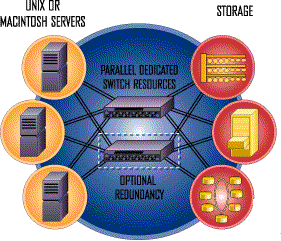|
Storage Area Network (SAN) installations are as diverse as the
businesses they serve. To enhance the range of solutions it provides,
Unylogix Technologies has developed various models based on various products and which offer
a unique set of product features essential to the deployment of
quality SANs.
The descriptions below correspond to the requirements of specific
customers and indicate the broad spectrum of end-user problems
that can be solved using Fibre Channel switches.
- Enterprise
SANs -- Scalable, highly-available environments impacting
the productivity of multiple areas within a company. (Data security
is often a prerequisite for success.)
- High-performance
SANs -- Immediate performance boosts for applications with
high bandwidth needs (Video editing, medical and seismic imaging,
etc.)
- Low-cost SANs
-- Basic SAN connectivity at the industry's lowest price point.

Fig. 1 -- As the Enterprise SAN changes and grows, end-users
will expect the system to maintain its original performance,
reliability and management attributes. |
Multiple applications
UNIX, NT or Mainframe platforms
Server or storage consolidation
Heterogeneous server clusters
Online transaction processing (OLTP)
Backup or remote site disaster recovery
|
Customers whose solutions encompass multiple enterprise activities
must maintain availability and security within a constantly changing
environment. To provide long-term value, these customers require
a SAN fabric that can adapt to the normal transitions of an organization
while satisfying user expectations of consistent performance and
ease-of-use.
One such solution by QLogic provides one of the most highly available and "future proof" fabrics
on the market. Built with enterprise needs in mind, QLogic's SANbox
products help SAN architects plan for the inevitable evolution of
their designs.
Availability
Multiple switch-to-switch links enable topologies with no single
point of failure. Hot-swappable parts and self-discovering, self-configuring
ports allow repairs and expansion while the network is still up
and running -- practically eliminating the possibility of user
down-time.
| QLogic advantage
More scalable
Easy installation and growth -- self-configuring fabric
Platform independence -- Web-based multi-chassis management
High interoperability
More reliable -- build topologies with no single point
of failure
|
Scalability
QLogic's Director-class products
provide modular scalability within a single chassis. In addition,
QLogic's unique Multistage cross-connect capability allows networks
to expand without adding the "hop" latency and congestion intrinsic
to all other multi-switch topologies (See Multi-switch tech brief). Fabric capacity actually grows as switches are added,
while overall latency remains constant.
Management
Superior multi-chassis management tools let users "see" at the
fabric, switch or port-level, unrestricted by platform or operating
system. QLogic's intuitive Web-based interface is supported by
an open systems architecture that easily integrates to a customer's
GUI of choice.
Specific management features include "hard zoning," an QLogic-exclusive
which establishes ironclad security between technologically differing
areas of a SAN (say UNIX and NT segments) or in heterogeneous
environments where confidentiality of information is essential.
Interoperability
Proven interoperability with most major adapter, storage and
software vendors plus long-term customer experience with IBM,
Sun, HP and various NT server installations gives QLogic fabrics
the additional advantage of compatibility with heterogeneous environments.
SANbox FLSTM
(Full Loop Support) leverages past infrastructure investments
by bringing legacy private loop devices forward into a full fabric
environment. Only SANbox FLS facilitates transactions between
all combinations of fabric, public and private devices.
 |
Applications
Video editing and movie production
Medical imaging
CAD/CAM
Geoseismic imaging
Defense applications
|
| QLogic advantage
100MB/sec (full-duplex) connection at every port
ASIC-embedded buffers (faster than shared memory architecture)
Latency under 500 nanoseconds
2KB frames with in-order delivery regardless of topology
|
Faster than a hub
True full-duplex Fibre Channel switching produces aggregate
speeds not possible using shared-media hubs. Although QLogic switches
support FC-AL ("loop") protocol at every port, bandwidth arbitration
among devices on a single port does not affect the performance
of the rest of the system. Individual servers or storage devices
still receive the dedicated 100MB/sec links necessary to run powerhouse
applications like HDTV video editing -- all within the stable,
manageable setting only a switch can sustain. (See "Low-cost SAN"
section.)
Faster than any other switch
SANbox switches are the best-performing switches in the industry,
thanks to QLogic's highly integrated multi-port ASIC. "Memory on
the chip" (instead of the more common shared buffer architecture)
saves transfer time and contributes to an ultra-low switch latency
interval. Roomy 2KB frames and guaranteed in-order frame delivery
maximize Fibre Channel's built-in efficiencies.
These benefits, already significant in single-switch fabrics,
can become critically important in multi-stage or cascaded environments.
 |
Applications/Requirements
Low-cost servers/storage
Server or storage consolidation
Sustainable performance with limited IT personnel resources
Cost-effective, incremental scalability
Support for legacy environments
|
Cost has always been a principal force driving the development
of SANs. The prospect of financial savings via pooled storage
resources, incremental hardware scalability, and centralized management
is now leading more organizations than ever before to explore
new storage strategies.
Until recently however, state-of-the-art SANs were not affordable
for many small and mid-sized enterprises. Switches were prohibitively
expensive and hubs, deployed in a few early SANs, did not meet
the performance and stability needs of business-critical applications
(see below).
QLogic advantage
Switch at hub prices
Loop support for low-cost storage
Low-cost scalability
- add devices incrementally
- cascade switches
Low lifetime costs
- Easy installation and management
|
QLogic has led the move to eliminate the cost barriers to high-performance
SANs. With entry-level switch prices now approaching those of managed
hubs, companies have little reason not to begin the migration to
a robust, full-featured storage infrastructure.
The Hidden Cost of Hubs
Hubs, once considered a low-cost alternative to switches, have
limitations which significantly affect their true cost of ownership.
Hubs not only share bandwidth -- they also share the instability
of each of the devices they link.
In FC-AL protocol, whenever a device enters a loop, it sends
out a loop initialization primitive (LIP) to request an address.
All other activity on the loop then comes to a complete stop as
each device reestablishes its connection within the new configuration.
Since a hub-based SAN is actually one large loop, it must be
entirely rebuilt every time a device -- even a single JBOD drive
-- is added or removed. Processing errors, disk failures or simply
rebooting a device can all incur LIPs. Worse, a phenomenon called
a "LIP storm" can cause multiple devices to send non-stop streams
of initialization commands, requiring a great deal of cost-intensive
hands-on attention by IT personnel until the problematic disk
or adapter is located and the loop restabilized.
Switches are stable
Switch fabrics, on the other hand, are easy to maintain and
relatively inexpensive to own. While hubs are only as strong as
their weakest link, switches allow IT planners to install as much
fault-tolerance as they need by isolating potentially unstable
or periodically reconfigured devices on their own loop segments.
Swapping drives on a switch-attached JBOD, for example, only causes
the JBOD itself to reinitialize -- the rest of the SAN maintains
full connectivity and performance.
QLogic's reliable products create additional lifetime cost-savings
due to their inexpensive scalability options, plug-and-play ports
and easy-to-use fabric management tools.
The overview of the SAN solution above specifically used the Qlogic products as examples. Attributes of the QLogic fabric solutions described above as well as our other fibre fabric switch solutions can
be applied in various combinations to meet the needs of any real-life
storage networking project. Flexibility and the industry's most
powerful feature-set makes Unylogix Technologies the first step toward
the profitable deployment of effective SANs.
|